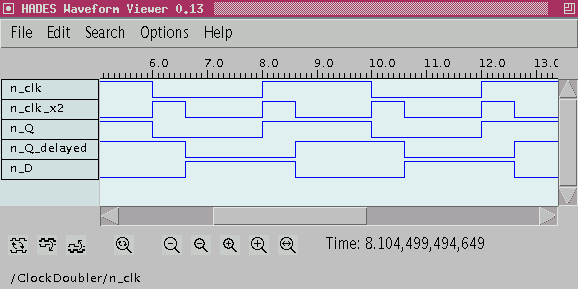

Applets
contents
visual index
 introduction
introduction std_logic_1164
std_logic_1164 gatelevel circuits
gatelevel circuits delay models
delay models
 gate vs. wir...
gate vs. wir...
 gate delay d...
gate delay d...
 ring oscillator
ring oscillator
 hazards
hazards
 NAND-chain
NAND-chain
 D-flipflop h...
D-flipflop h...
 clock-doubler
clock-doubler
 2-phase cloc...
2-phase cloc... flipflops
flipflops adders and arithm...
adders and arithm... counters
counters LFSR and selftest
LFSR and selftest memories
memories programmable logic
programmable logic state-machine editor
state-machine editor misc. demos
misc. demos I/O and displays
I/O and displays DCF-77 clock
DCF-77 clock relays (switch-le...
relays (switch-le... CMOS circuits (sw...
CMOS circuits (sw... RTLIB logic
RTLIB logic RTLIB registers
RTLIB registers Prima processor
Prima processor D*CORE
D*CORE MicroJava
MicroJava Pic16 cosimulation
Pic16 cosimulation Mips R3000 cosimu...
Mips R3000 cosimu... Intel MCS4 (i4004)
Intel MCS4 (i4004) image processing ...
image processing ... [Sch04] Codeumsetzer
[Sch04] Codeumsetzer [Sch04] Addierer
[Sch04] Addierer [Sch04] Flipflops
[Sch04] Flipflops [Sch04] Schaltwerke
[Sch04] Schaltwerke [Sch04] RALU, Min...
[Sch04] RALU, Min... [Fer05] State-Mac...
[Fer05] State-Mac... [Fer05] PIC16F84/...
[Fer05] PIC16F84/... [Fer05] Miscellan...
[Fer05] Miscellan... [Fer05] Femtojava
[Fer05] Femtojava FreeTTS
FreeTTS Note that the duration of the 1-phase of the output clock signal
is the same as the delay through the delay inverters.
In a real circuit, the gate delay through the delay path will be
only a few nanoseconds, and therefore the duration of the
output clock pulses will also be only a few nanoseconds.
Note that the duration of the 1-phase of the output clock signal
is the same as the delay through the delay inverters.
In a real circuit, the gate delay through the delay path will be
only a few nanoseconds, and therefore the duration of the
output clock pulses will also be only a few nanoseconds.